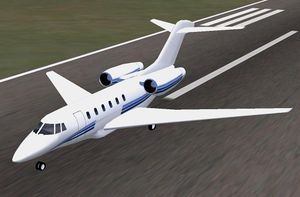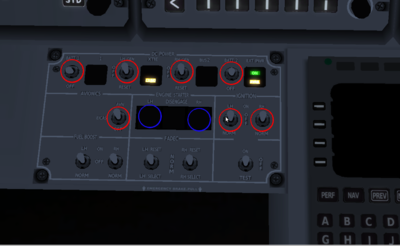Cessna Citation X: Difference between revisions
(Add approach and landing hints) |
mNo edit summary |
||
| Line 20: | Line 20: | ||
(following the procedure in the tutorial) | (following the procedure in the tutorial) | ||
[[File:Citationx-power+avionics.png| | [[File:Citationx-power+avionics.png|400px|Screenshot of Citation X cockpit detail (Power and Avionics panel) with buttons to press during startup highlighted.Designer of Flightgear Citation X plane: Syd Adams]] | ||
Power and Avionics panel in front of pilot: | Power and Avionics panel in front of pilot: | ||
Revision as of 22:53, 6 November 2013
 | |
| Type | Business jet |
|---|---|
| Author(s) | Syd Adams |
| FDM | YASim |
| --aircraft= | CitationX |
| Status | Early production |
| FDM |
|
| Systems |
|
| Cockpit |
|
| Model |
|
The Cessna Citation X (X as in the Roman numeral for ten, not the letter) is a long range medium business jet aircraft. The X is currently the fastest civilian jet in production with a top speed of Mach 0.92 (703 mph). This also makes it the fastest business jet in history. The Citation X is powered by two Rolls-Royce turbofan engines and is built by the Cessna Aircraft Company in Wichita, Kansas. The Citation brand of business jets encompasses six distinct "families" of aircraft. Although based on the earlier Citation III, VI and VII models the Citation X is a significantly different airplane. It utilizes a totally new wing design, engines, and features a glass cockpit.
Aircraft help
Startup
(following the procedure in the tutorial)
Power and Avionics panel in front of pilot:
- Battery L + R switches on
- Generator L + R switches on
- Avionics switch on
- Ignition L + R on
Lights:
- Gnd/Rec anticoll on (on lower central panel on co-pilot side)
- Taxi on (central console - copilot side, next to flaps)
Start Engines:
- Throttle: to idle
- Press Engine starter button L+R
- Throttle: spool up
Taxi
- Nav lights on
- Release parking: Shift-B
- Max Taxiing speed 20 kts
Take Off
Preparation
- Landing lights on (central panel)
- Recog on
- Taxi light off
- Flaps 5 deg
Take Off
- Thrust: TO (take/off ~95%)
Note that you will lose tiller control at about 50 knots and no more control on yaw is possible; make sure you are aligned well before reaching this speed
- Vr=130 kts (pull hard on yoke such that front wheels leave ground)
- V2=140 kts (rear wheels leave ground)
- Retract landing gear as soon as you have left the ground (G)
- 1500 ft above ground: flaps up
Climb out
- Landing lights off
- 250 kts (do not exceed below 10000 ft)
- 280 kts (above 10000 ft)
- At Transition Altitude set altimeter to 29.92 (1013)
- Max speed 345 kts at FL240-280 (24000-28000 ft)
Approach and Landing
- Descent speed (280 kts to FL120, 250 kts below 10000 fts)
- Turn on landing lights
- Reduce speed (throttle to idle)
- 180 kts Flaps 5 deg
- 140 kts Flaps 15 deg
- 130 kts lower landing gear
At final stretch toward runway
- 125 kts Flaps 35 deg
- 120 kts Landing speed
After touchdown
- Lower nose wheel
- Deploy spoilers (Ctrl-B)
- Reverse thrust (del)
- at 60 knots: cancel reverse (del)
- Manual brakes
Taxi
- flaps up
- Landing lights off
- Recog light off
- Taxi light on
- max 20 kts
During descent use the auto-pilot (VS mode) to control the rate of descent, and the throttle to control airspeed. In order to effect the initial speed reduction, the place the throttle in idle. As you deploy the larger flaps levels (15+) the aircraft can slow down quite quickly, and you will have to actively manage the throttle to avoid a dramatic loss of airspeed. Particularly for the full flaps extension it is very difficult to maintain sufficient airspeed to prevent fast descent so deploy these only when you are quite near the runway.
Configuration speed limits [1]
| Flaps 5 deg | 250 kts |
| Flaps 15 deg | 210 kts |
| Flaps >15 deg | 180 kts |
| Gear down | 210 kts |
When and how fast to descend?
The following rules-of-thumb apply will give you a glide slope angle of 3 deg and are easily worked out using basic trigonometry.
- Altitude above airport ground (ft) should be about 318 times distance left to fly to runway head (nm)
Examples:
- You are flying at 20000 ft, and the airport is at 1000 ft. Your descent should start at about (20000-1000)/318 ~ 60 nm left to fly
- You are 10 nm from the airport. Your altitude should be airport altitude plus 318*10 ~ 3200 ft
- Assuming you are at about the correct altitude your vertical descent speed (ft/min) should be 5.3 times your speed relative ground (kts, from GPS, NOT airspeed)
Example:
- You are flying at 200 kts rel. ground. Your vertical descent speed should be 200*5.3=1060 ft /min
References
Related content
- Click here for a review of the Cessna Citation X.
| ||||||||
